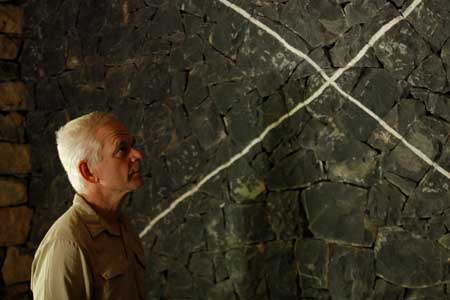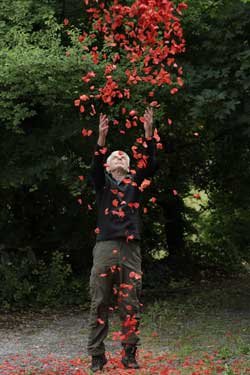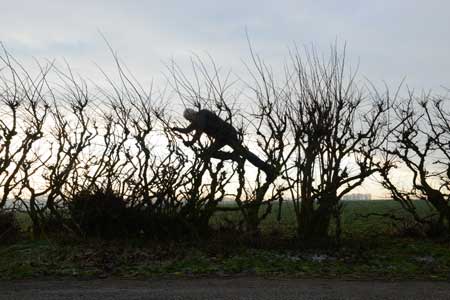Film (2018)
Documentary
by Thomas Riedelsheimer
Music by Fred Frith
Kendall Square Cinema
Cambridge, MA
With Andy Goldsworthy, Holly Goldsworthy

LEANING INTO THE WIND
a Magnolia Pictures release.
Photo courtesy of Magnolia Pictures.
Photo Credit: © Thomas Riedelsheimer, all rights reserved.
Rivers and Tides (2001), a documentary on Andy Goldsworthy’s art, gave a good taste of his deliberate, painstaking and ingenious approach to the construction of his works, many of which were created exclusively from natural materials and set within naturalistic environments. In a scene from that film, Goldsworthy builds a smallish tower of rocks in the water. The construction is not trivial, and somewhere quite far along the line the whole thing collapses. Goldsworthy watches as his hours of work falls apart before him and utters a mild response like Oh, drat. It seems part and parcel of his enterprise to be patient.
One watches, also, in that earlier film, how Goldsworthy pursues his art-making deliberating and single-mindedly, while his passel of young children swirl around him. Though not exactly inattentive, Goldsworthy’s absorption with his art-making is apparent as he yields the greater immediacies of child-rearing to his then wife.
Now, seventeen years later, Goldsworthy has whitened and wizened, though his charms and his inventive capacities are still vividly present. In addition, His daughter Holly, now a young woman, and one of the children who in that earlier film was running around screaming while Goldworthy dreamed and fabricated any number of his many ingenious inventions, is his assistant and appears in Leaning Into The Wind in connection with the construction of multiple works.

LEANING INTO THE WIND
a Magnolia Pictures release.
Photo courtesy of Magnolia Pictures.
Photo Credit: © Thomas Riedelsheimer, all rights reserved
Leaning Into The Wind takes its title from a work, so to speak, of Goldsworthy’s that shows up at the end of the film. Wrapped in rain and wind gear, Goldsworthy approaches the side of a mountain near his home in Scotland where the wind is particularly fierce. We watch as he literally leans into the wind and tries to achieve a perfect moment of balance between the force of gravity and the upswell of the wind. After multiple tries, he achieves it and we recognize, as we do in so many of Goldsworthy’s works, a moment of pristine silence, of brilliantly captured essences, that derive almost completely from his interaction with the natural environment surrounding him.
The film begins in rural Brazil with Goldsworthy inspecting an adobe house and shed belonging to an old couple. He observes the structure meticulously and at a certain point enacts a kind of ballet using flourishes of dust in a projected laser beam within the shed. Goldsworthy remarks, as he observes the house with wonder, how he feels he is almost invading a kind of intimacy by looking so closely at the inner workings of the construction. I’m just trying to make sense of the world, he says as he penetrates the secrets within.
Following up this expedition we see what seems to be the creative outgrowth of Goldsworthy’s Brazilian research: a construction in the Presidio section of San Francisco which involves the installation of a large tree trunk inside a small almost chapel-like interior. The trunk is prepared with cross hatches done with chain saws and then covered with adobe. Adobe bricks made of clay and hair are set into the walls and ceiling and plastered over. And the tree trunk, with beautifully a crinkled adobe exterior is mounted in the ceiling. Every step is meticulously presented, even Goldsworthy’s chatter with the hired chainsaw guy with whom he shares stories of shoulder surgeries.
Each project depicted in the film is detailed with this kind of care, and filmmaker Thomas Riedelsheimer follows Goldsworthy at each step seeking to draw from him a kind of running commentary on his philosophy of art.
Discussing and demonstrating his relationship to a fallen elm tree on the land near his home in Scotland, Goldsworthy describes and displays the elaborate embellishments he created at various points to honor the create cracks and fissures that developed in its trunk. Hogwood sticks carefully arrayed become a fragile stuffing for the spaces between. At another point, yellow leaves, carefully collected during fall, are used as a kind of applique pseudo-paint to create vivid and delightful patterns on the trunk.

LEANING INTO THE WIND
a Magnolia Pictures release.
Photo courtesy of Magnolia Pictures.
Photo Credit: © Thomas Riedelsheimer, all rights reserved.
As well as exhibiting his relationship to the home terrain, Goldsworthy talks about it and gives a vivid sense of what it has meant to him to feel out and respond to the subtleties of the changes that occur around him.
At one point we watch an elongated scene in which Goldsworthy climbs down the length of a row of low hedge-trees, wending his way through a morass of branches. The process is attenuated, as are many of his endeavors, and oddly engrossing. We also hear, as a follow-up, of the months of rib pain he endured as a sequel to the enterprise, all part, in some way of the experience and all strangely fascinating.
My work isn’t so clear anymore, he says, referring to the present, years after his initial successes as an environmental nature artist, claiming that now all aspects of the world, including his encounters within cities, fall within the scheme of the natural.
The film is beautifully shot by Riedelsheimer and has an engaging and stimulating soundtrack by Fred Frith. Scene after scene captivates the eye. In one, Goldsworthy, mouth stuffed with leaves, spits them out in great fanfare, their dispersed array fluttering down with an enormous cape of color.
Anticipating the ending and calling forth the film’s title, Goldsworthy says: That’s the beauty of art; it makes you step off the normal way of looking… Learning to fall is important. That moment when you’re held there is a moment of understanding and clarity.
This visually beautiful and engrossing film is a fine sequel to Rivers and Tides and on its own terms a great tribute to and insight into one of the era’s most interesting and celebrated artists.
– BADMan
Leave a Reply